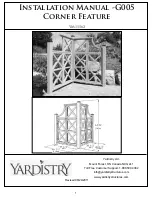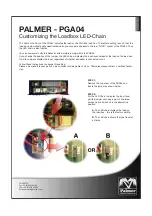
FluoroMax-3 v. 3 (22 Feb 2005)
System Description
2-4
tor’s slits control the intensity of the fluorescence signal recorded by the signal detec-
tor. When setting slit width, the trade-off is intensity of signal versus spectral resolu-
tion. The wider the slits are, the more light falls on the sample and detector, but the
resolution decreases. The narrower the slits are, the higher the resolution gets, but at the
expense of signal. Set the slits for intensity toward the higher end of the detector’s lin-
ear response, with sharp-enough resolution to discern desired spectral features.
Slits may be set in bandpass units, or the physical width of the slit (mm). Under band-
pass units, each monochromator’s slits are set simultaneously, for the bandpass is de-
termined by the dispersion of the monochromator:
bandpass (in nm) = slit width (in mm) × dispersion (in nm mm
–1
)
The dispersion of FluoroMax
®
-3 monochromators is 4.25 nm mm
–1
for gratings with
1200 grooves mm
–1
. Below is a table showing standard slit widths with their corre-
sponding bandpasses.
Slit width (mm)
Bandpass (nm) Rounded bandpass (nm)
0.50 2.125
2
1.175 4.994 5
2.00 8.500
8.5
Shutters
An excitation shutter, standard on the FluoroMax
®
-3, is located just after the excitation
monochromator’s exit slit. The shutter protects samples from photobleaching or photo-
degradation from prolonged exposure to the light source. FluorEssence™ controls the
shutter, and can set the shutter to automatic or photobleach modes. An emission shutter
is an optional accessory, placed just before the emission monochromator’s entrance,
and protects the detector from bright light.
Sample compartment (3)
A toroidal mirror focuses the beam from the excitation monochromator on the sample.
About 8% of this excitation light is split off, using a beam-splitter, to the reference pho-
todiode. Fluorescence from the sample is then collected and directed to the emission
spectrometer.
The sample compartment accommodates various optional accessories, as well as fiber-
optic bundles to take the excitation beam to a remote sample (or the MicroMax), and
return the emission beam to the emission monochromator. See Chapter 7 for a list of
accessories.
Caution:
Operation of the instrument when the excita-
tion shutter is disabled may expose the user to exces-
sive light. Wear light-blocking goggles or face-shield,
and light-blocking clothing and gloves.
Содержание FluoroMax-3
Страница 5: ...FluoroMax 3 v 3 1 3 Mar 2006 v 15 Declaration of Conformity 15 1 16 Index 16 1...
Страница 6: ...FluoroMax 3 v 3 1 3 Mar 2006 vi...
Страница 18: ...FluoroMax 3 v 3 1 3 Mar 2006 Introduction 0 12...
Страница 36: ...FluoroMax 3 v 3 22 Feb 2005 System Description 2 8...
Страница 96: ...FluoroMax 3 v 3 1 3 Mar 2006 Maintenance 6 12...
Страница 156: ...FluoroMax 3 v 3 1 6 Mar 2006 Automated Polarizers 10 22...
Страница 208: ...FluoroMax 3 v 3 1 6 Mar 2006 Bibliography 14 4...
Страница 210: ...FluoroMax 3 v 3 1 6 Mar 2006 Declaration of Conformity 15 2...
Страница 220: ...FluoroMax 3 v 3 1 25 Apr 2006 Index 16 10...
















































